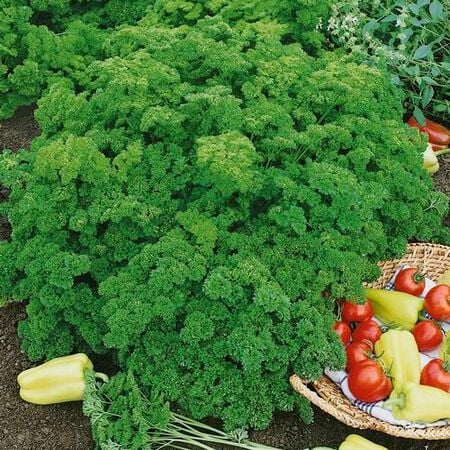Evergreen, Organic Parsley Seed
Key Attributes
Key Attributes
Product Details
Weight
0.00087Plant Height
12-18"Botanical Name
Petroselinum crispum 'Evergreen'Seed Type
SeedAdditional Characteristics
All American SelectionSeeds Per Gram
505Seeds Per Pound
228,800Packet
200 SeedsSow Depth
1/4"Seeds Per Ounce
14,300Breed
Open-pollinatedSun
Full Sun / Partial ShadeGrowing Conditions
Container FriendlyLife Cycle
BiennialSow Method
TransplantDirect SowCategories
HerbGermination
22,23,24,14,25,15,26,16,27,17,28,18,19,20,21Days To Maturity (# Days)
70Organic
OrganicHeirloom
HeirloomComponents
Growing Instructions
![]() Learning Download: How to Grow Parsley
Learning Download: How to Grow Parsley
Parsley is a very common herb grown in the garden. It has a fern-like appearance, and it is typically used as a garnish to beautify meals and has a slightly bitter taste. Parsley works well when planted along a border, and it contains vitamins like calcium, potassium and vitamin C. Parsley is in the same family as dill. Flat-leafed parsley is best used for cooking since it has a stronger flavor and curly-leaf parsley makes a prettier garnish.
Before Planting: Like most herbs, parsley can be grown indoors, in a container or in the garden. To encourage parsley to have a better germination, soak the seeds in water overnight.
Planting: Parsley seeds can be sown directly into the garden as soon as the soil can be worked in the spring, but they also can be started indoors six weeks before moving out to the garden since parsley has a slow germination
rate of three weeks or longer. Parsley seeds are small, so to plant just sprinkle them over the soil and do not cover with more soil.
Watering: Parsley requires little maintenance and only needs watering once per week.
Fertilizer: If growing parsley in the ground, parsley does best with a single application of fertilizer halfway through the growing season with a 5-10-5 fertilizer. Growing parsley in pots calls for more fertilizer, so apply fertilizer every six weeks for pots indoors and every four weeks if grown in pots outdoors.
Days to Maturity: Once parsley leaves begin to curl or when the leaves have three separate segments, they are ready to harvest. (See each variety for days to harvest)
Harvesting: Pick parsley leaves early in the morning as that is when the herb’s scent is the strongest. To harvest parsley, cut the leaves from the outer part of the plant first. To store fresh parsley, snip entire stems and keep the stems immersed in water in the refrigerator.
Tips: Parsley is mostly disease resistant, though it can be a victim to aphids.
Shipping Schedule
Our Seed Promise
 "Agriculture and seeds" provide the basis upon which our lives depend. We must protect this foundation as a safe and genetically stable source for future generations. For the benefit of all farmers, gardeners and consumers who want an alternative, we pledge that we do not knowingly buy or sell genetically engineered seeds or plants.
"Agriculture and seeds" provide the basis upon which our lives depend. We must protect this foundation as a safe and genetically stable source for future generations. For the benefit of all farmers, gardeners and consumers who want an alternative, we pledge that we do not knowingly buy or sell genetically engineered seeds or plants.
The mechanical transfer of genetic material outside of natural reproductive methods and between genera, families or kingdoms, poses great biological risks as well as economic, political, and cultural threats. We feel that genetically engineered varieties have been insufficiently tested prior to public release. More research and testing is necessary to further assess the potential risks of genetically engineered seeds. Further, we wish to support agricultural progress that leads to healthier soils, to genetically diverse agricultural ecosystems, and ultimately to healthy people and communities.
To learn more about the "Safe Seed Pledge" please visit www.councilforresponsiblegenetics.org.

